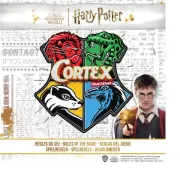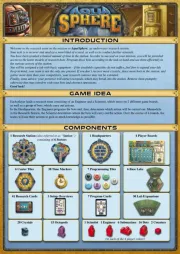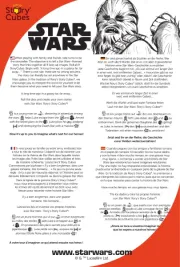Gamewright Marshmallow Test Handleiding
Gamewright
Bordspel
Marshmallow Test
Bekijk gratis de handleiding van Gamewright Marshmallow Test (2 pagina’s), behorend tot de categorie Bordspel. Deze gids werd als nuttig beoordeeld door 18 mensen en kreeg gemiddeld 4.9 sterren uit 9.5 reviews. Heb je een vraag over Gamewright Marshmallow Test of wil je andere gebruikers van dit product iets vragen? Stel een vraag
Pagina 1/2

CONTENTS
CONTENTS
CONTENTS
CONTENTSCONTENTS
60 cards (1–12 in 5 colors)
20 small & 15 large marshmallow tokens (1 & 5 points)
OVERVIEW
OVERVIEW
OVERVIEW
OVERVIEWOVERVIEW
Are you all about instant gratication? Or can you be patient enough to wait
for a greater reward later? Test your willpower by winning tricks and collecting
marshmallows for your opponents’ tricks. The rst player to 20 points wins.
SET UP
SET UP
SET UP
SET UPSET UP
1. The player who last ate something with marshmallows starts as the dealer
for the rst round.
2. Shufe the deck and deal each player a hand of 12 cards. (Keep your hand
secret from opponents.) Place any remaining cards off to the side, unseen.
3. Place the marshmallow
tokens within easy reach
of all players. Note that
small marshmallows are
worth 1 point each, while
large marshmallows are
worth 5 points each.
5 points
oint
HOW TO PLA
HOW TO PLA
HOW TO PLA
HOW TO PLAY
Y
Y
YHOW TO PLAY
The dealer begins the round by playing a card from their hand face up to the
middle of the playing area, starting the “trick.” Play proceeds clockwise, with
each player adding one of their own cards face up to the trick as well.
When playing a card, the following rules apply:
• Any card can be played as the rst card of a trick. This card determines the
trick’s “lead suit.”
• All subsequent cards in the trick must follow the lead suit (match the
color of the rst card). If none of your cards match the lead suit, you may
play any card from your hand.
When each player has played a card, whoever played the highest card in the
lead suit wins the trick. Note: During the rst round, there is no trump suit (see
“Starting a New Round” for more). The player who won the trick collects all of
the cards from the center of the play area, and puts them in a stack face down
in front of themself. (As you collect further tricks, place each one in a separate
stack, so that it’s clear how many tricks each player has.) The winner of that trick
continues the round by playing a card from their hand to start the next trick.
GOING OUT
GOING OUT
GOING OUT
GOING OUTGOING OUT
Once a player collects a specic number of tricks, they’re out for the rest of the
round and receive marshmallow tokens equal to the total number of all other
players’ face-down tricks. The number of tricks required varies based on the
number of players, as follows:
Number of Players 2 3 4 5
Number of Tricks 6 4 3 3
After you go out discard any remaining cards in your hand to the side, face down,
but leave your tricks in front of you, as these will continue to be counted toward
other players’ scores. Of the remaining players, the next player in clockwise order
starts the next trick.
Example: In this four-player game, Player A
has just won their third trick, and therefore
goes out for the round. They collect a total
of 4 marshmallow tokens: 2 for Player B’s
tricks and 1 each for Player C’s and D’s
tricks. Player B starts the next trick.
ENDING A ROUND
ENDING A ROUND
ENDING A ROUND
ENDING A ROUNDENDING A ROUND
A round ends when there’s only one player remaining who hasn’t gone out. That player
does not receive any marshmallows, and becomes the dealer for the next round.
STARTING A NEW ROUND
STARTING A NEW ROUND
STARTING A NEW ROUND
STARTING A NEW ROUNDSTARTING A NEW ROUND
The dealer for the second round (and beyond) reshufes all the cards (including
any that were set aside) and deals each player a new hand of 12 cards. Then —
after the dealer has examined their cards — they declare one of the ve suits
as the “trump suit.” Cards of this suit will beat all other suits for the duration of
the round.
Green is
trump!
Special Rule for Five Players: In a ve-player game, it’s possible that
more than one player remains in the round, even after all 12 tricks
have been played. When this happens, of the remaining players none
receive any marshmallows. If the player who collected the most recent
trick has gone out, they are the dealer for the next round. However not
if the player who collected the most recent trick go out, they did
receive their marshmallows as usual and the rst player, in clockwise
order, who still remains in the round becomes the next dealer instead.
Player A
Player B
Player D
Player C The dealer begins the round, as before, and the round plays out just like the previous
one, with the following addition:
• If a player is unable to follow suit and adds a trump card to a trick,
all following players may also play a trump to that trick — even if they
could otherwise still follow suit.
When each player has played a card, the winner of the trick is determined as follows:
• If any trump cards were played, the highest trump card wins the trick.
• If no trump cards were played, the highest card in the lead suit wins the trick.
ENDING THE GAME
ENDING THE GAME
ENDING THE GAME
ENDING THE GAMEENDING THE GAME
Continue playing rounds until one player collects a total of 20 (or more) points.
The game ends instantly when this happens. The current round is not completed,
and the successful player is the winner.
A WORD FROM GAMEWRIGHT
A WORD FROM GAMEWRIGHT
A WORD FROM GAMEWRIGHT
A WORD FROM GAMEWRIGHTA WORD FROM GAMEWRIGHT
In case you’ve never heard of it, the title of this game comes from “the Stanford
marshmallow experiment,” a series of studies on delayed gratication conducted
by psychologist Walter Mischel in the late 1960s and early 1970s. In the studies,
children were offered a choice between receiving one marshmallow immediately
or two marshmallows if they waited a little while longer. Inspired by the famous
experiment, inventor Reiner Knizia created this clever trick-taking game that
rewards patience. If you can gure out how to be the second-to-last to go out
each round, you’ll nd this game to be quite gratifying!
70 Bridge Street, Newton, MA 02458
jester@gamewright.com | 617-924-6006
gamewright.com
©2020 Gamewright, a division of Ceaco Inc.
All rights reserved.
FOLLOW US!
FOLLOW US!
FOLLOW US!
FOLLOW US!FOLLOW US!
Game by: Reiner Knizia
GAME
fb.com/gamewright
@gamewright
youtube.com/gamewright
@gamewright
2-5
PLAYERS
10+
AGES

CONTENIDO
CONTENIDO
CONTENIDO
CONTENIDOCONTENIDO
60 cartas (1–12 en 5 colores).
20 chas de malvavisco pequeñas y 15 grandes (1 y 5 puntos).
RESEÑA
RESEÑA
RESEÑA
RESEÑARESEÑA
¿Estás interesado en la graticación instantánea o puedes ser lo sucientemente
paciente como para esperar una recompensa mayor más adelante? Pon a prue-
ba tu fuerza de voluntad ganando bazas y recogiendo malvaviscos por las bazas
de tus oponentes. El primer jugador en obtener 20 puntos gana.
PREP
PREP
PREP
PREPARA
ARA
ARA
ARACIÓN
CIÓN
CIÓN
CIÓNPREPARACIÓN
1. El último jugador que comió algo con malvavisco comienza como
repartidor de la primera ronda.
2. El repartidor baraja el mazo y reparte a cada jugador una mano de 12 cartas.
(Mantén tu mano en secreto de los oponentes.) Las cartas restantes se colocan
a un lado, sin ser vistas.
3. Coloca las chas de malvavisco
al alcance de todos los
jugadores. Ten en cuenta que
los malvaviscos pequeños vale
1 punto cada uno, mientras que
los malvaviscos grandes valen
5 puntos cada uno.
CÓMO JUGAR
CÓMO JUGAR
CÓMO JUGAR
CÓMO JUGARCÓMO JUGAR
El repartidor comienza la ronda jugando una carta desde su mano boca arriba
en el centro del área de juego, comenzando la “baza”. El juego continúa en el
sentido horario, y cada jugador agrega una de sus propias cartas boca arriba a
la baza también. Al jugar una carta, se aplican las siguientes reglas:
• Cualquier carta se puede jugar como la primera carta de una baza. Esta
carta determina el “palo principal” de la baza.
• Todas las cartas posteriores en la baza deben seguir el palo principal
(debe coincidir con el color de la primera carta). Si ninguna de tus cartas
coincide con el palo principal, puedes jugar cualquier carta de tu mano.
Cuando cada jugador p2-ha jugado una carta, quien haya jugado la carta más alta
en el palo principal gana la baza. Nota: Durante la primera ronda, hay palo no
de triunfo (ver “Comenzar una nueva ronda” para más información). El jugador
que gana la baza recoge todas las cartas del centro del área de juego y las
coloca en una pila frente a sí mismo. (A medida que recolectes más boca abajo
bazas, coloca cada una en una pila separada, para que quede claro cuántas
bazas tiene cada jugador). El ganador de la baza continúa la ronda jugando una
carta de su mano para comenzar la siguiente baza.
QUED
QUED
QUED
QUEDAR FUERA
AR FUERA
AR FUERA
AR FUERAQUEDAR FUERA
Una vez que un jugador recolecta una cantidad especíca de bazas, queda fuera
por el resto de la ronda y recibe chas de malvavisco equivalentes a la cantidad
total de bazas boca abajo de todos los . Dependiendo del númedemás jugadores -
ro de jugadores, esto ocurre después de recolectar el siguiente número de bazas:
Número de Jugadores 2 3 4 5
Número de Bazas 6 4 3 3
Después de quedar fuera, descarta las cartas restantes en tu mano a un lado,
boca abajo, pero deja tus bazas frente a ti, p2-ya que estas se seguirán contando
para los puntajes de otros jugadores. De los jugadores restantes, el siguiente
jugador en sentido horario comienza la siguiente baza.
Ejemplo: En un juego de cuatro jugadores,
el jugador A ganó su tercera baza y,
por lo tanto, queda fuera de la ronda.
El recolecta un total de 4 chas de
malvavisco: 2 por las bazas del jugador B
y 1 por las bazas de los jugadores C y D.
El jugador B comienza la siguiente baza.
TERMINANDO UNA ROND
TERMINANDO UNA ROND
TERMINANDO UNA ROND
TERMINANDO UNA RONDA
A
A
ATERMINANDO UNA RONDA
Una ronda termina cuando solo queda un jugador que no p2-ha quedado fuera. Ese
jugador no recibe malvaviscos y se convierte en el repartidor de la próxima ronda.
Regla especial para cinco jugadores: en un juego de cinco jugadores, es
posible que quede más de un jugador incluso después de haber jugado las
12 bazas. Cuando esto sucede, de los jugadores restantes recibe ninguno
malvaviscos. Si el jugador que recolectó la baza más reciente p2-ha no queda-
do fuera, es el repartidor de la próxima ronda. Sin embargo, si el jugador que
recolectó la baza más reciente quedó fuera como resultado de esto, recibirá
sus malvaviscos como de costumbre y el primer jugador, en sentido horario,
que aún permanece en la ronda se convierte en el siguiente repartidor.
COMENZANDO UNA NUEV
COMENZANDO UNA NUEV
COMENZANDO UNA NUEV
COMENZANDO UNA NUEVA ROND
A ROND
A ROND
A RONDA
A
A
ACOMENZANDO UNA NUEVA RONDA
El repartidor de la segunda ronda (y más allá) baraja todas las cartas (incluidas
las que se apartaron) y reparte a cada jugador una nueva mano de 12 cartas.
Luego, después de que el repartidor haya examinado sus cartas, él declara uno
de los cinco palos como el palo de “triunfo”. Las cartas de este palo vencerán a
todos los otros palos mientras dure la ronda.
¡El verde
es triunfo!
El repartidor comienza la primera baza de la ronda, como antes, y la ronda se
desarrolla igual que la anterior, con la siguiente adición:
• Si un jugador no puede seguir el palo principal y agrega una carta de triunfo
a una baza, todos los siguientes jugadores también pueden jugar un triunfo
en esa baza, incluso si de lo contrario aún pudieran seguir el palo principal.
Cuando cada jugador p2-ha jugado una carta, el ganador de la baza se determina
de la siguiente manera:
• Si se jugó alguna carta de triunfo, la carta de triunfo más alta gana la baza.
• Si no se jugaron cartas de triunfo, la carta más alta del palo principal gana la baza.
TERMINANDO EL JUEGO
TERMINANDO EL JUEGO
TERMINANDO EL JUEGO
TERMINANDO EL JUEGOTERMINANDO EL JUEGO
Continúen jugando rondas hasta que un jugador recolecte un total de 20 (o
más) puntos. El juego termina instantáneamente cuando esto sucede. La ronda
actual no se completa y el jugador exitoso es el ganador.
UNAS P
UNAS P
UNAS P
UNAS PALABRAS DE GAMEWRIGHT
ALABRAS DE GAMEWRIGHT
ALABRAS DE GAMEWRIGHT
ALABRAS DE GAMEWRIGHTUNAS PALABRAS DE GAMEWRIGHT
En caso de que nunca hayas oído hablar de él, el título de este juego proviene del
“experimento de malvaviscos de Stanford”, una serie de estudios sobre la grati-
cación retrasada realizados por el psicólogo Walter Mischel a nes de los años 60 y
principios de los 70. En los estudios, a los niños se les ofreció elegir entre recibir un
malvavisco de inmediato o dos malvaviscos si esperaban un poco más. Inspirado
por el famoso experimento, el diseñador Reiner Knizia creó este inteligente juego
de bazas que recompensa la paciencia. Si puedes descubrir cómo ser el penúltimo
en quedar fuera en cada ronda, ¡encontrarás este juego bastante graticante!
70 Bridge Street, Newton, MA 02458
jester@gamewright.com | 617-924-6006
gamewright.com
©2020 Gamewright, una división de Ceaco Inc.
Todos los derechos reservados.
¡SÍGUENOS!
¡SÍGUENOS!
¡SÍGUENOS!
¡SÍGUENOS!¡SÍGUENOS!
Juego de Reiner Knizia
LA PRUEBA DEL MALVAVISCO
EL JUEGO DE BAZAS DE GRATIFICACIÓN RETRASADA
MR
2-5
JUGADORES
10+
EDADES
fb.com/gamewright
@gamewright
youtube.com/gamewright
@gamewright
Jugador A
Jugador B
Jugador D
Jugador C
5 puntos
unto
Product specificaties
| Merk: | Gamewright |
| Categorie: | Bordspel |
| Model: | Marshmallow Test |
| Aanbevolen leeftijd (min): | 10 jaar |
| Land van herkomst: | China |
| Voorgesteld geslacht: | Elk geslacht |
| Verpakkingsinhoud: | 60 cards\n35 Marshmallow scoring tokens\nRules in Spanish\nRules of Play |
| Aanbevolen leeftijdscategorie: | Volwassene & kind |
| Minimum aantal spelers: | 2 |
| Type product: | Kaartspel |
| Aantal kaarten: | 60 stuk(s) |
| EU TSD-waarschuwing: | Kleine onderdelen. Stikkingsgevaar |
| Niet voor kinderen 0 - 3 jaar: | Ja |
| Speeltijd (max): | 20 min |
| Maximum aantal spelers: | 5 |
| Genre: | Feest |
| Familiespel: | Ja |
| Naam game: | Marshmallow Test |
Heb je hulp nodig?
Als je hulp nodig hebt met Gamewright Marshmallow Test stel dan hieronder een vraag en andere gebruikers zullen je antwoorden
Handleiding Bordspel Gamewright

25 Februari 2025

25 Februari 2025

25 Februari 2025

31 Juli 2024

29 Juli 2024

29 Juli 2024

29 Juli 2024

29 Juli 2024

29 Juli 2024

29 Juli 2024
Handleiding Bordspel
- Marbushka
- Amigo
- Philos
- Reisspellen
- MindWare
- Ravensburger
- Megableu
- Thames & Kosmos
- Asmodee
- Flying Tiger
- Jumbo
- Outdoor Play
- Gezelschapsspellen
- Drei Magier Spiele
- Spin Master
Nieuwste handleidingen voor Bordspel

3 Juli 2025

1 Juli 2025

30 Juni 2025

19 April 2025

19 April 2025

19 April 2025

19 April 2025

19 April 2025

6 April 2025
